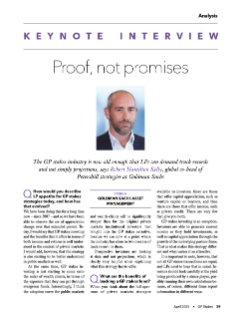Proof, Not Promises
How would you describe LP appetite for GP stakes strategies today, and how has that evolved?
We have been doing this for a long time now – since 2007 – and so we have been able to observe the arc of appreciation change over that extended period. Today, I would say that GP stakes investing and the benefits that it offers in terms of both income and returns is well understood in the context of private markets. I would add, however, that the strategy is also starting to be better understood in public markets as well.
At the same time, GP stakes investing is just starting to come onto the radar of wealth clients, in terms of the exposure that they can get through evergreen funds.
Interestingly, I think the adoption curve for public markets and wealth clients will be significantly steeper than was the case for the original private markets institutional investors that bought into the GP stakes narrative, because we are now at a point where the industry has close to two decades of track record to share.
Prospective investors are looking at data and not projections, which is clearly very helpful when explaining what this strategy has to offer.
What are the key benefits of investing in a GP stakes fund for LPs?
When you think about the full spectrum of private markets strategies available to investors, there are those that offer capital appreciation, such as venture capital or buyouts, and then there are those that offer income, such as private credit. There are very few that give you both.
GP stakes investing is an exception. Investors are able to generate current income as they hold investments, as well as capital appreciation through the growth of the underlying partner firms. That is what makes this strategy different and what makes it so attractive.
It is important to note, however, that not all GP stakes transactions are equal, and LPs need to bear that in mind. Investors should look carefully at the yield being produced by a stakes player, possibly running their own calculations because, of course, different firms report information in different ways.
Meanwhile, in addition to the financials, LPs may want to consider the other advantages that exposure to a GP stakes strategy can bring, in terms of those relationships with GPs that can lead to opportunities to deploy further LP dollars.
That relationship aspect of GP stakes investing sits alongside the economic benefits when investors are evaluating what the strategy can add to their private markets portfolio.
You mentioned the wealth channel. Do you see GP stakes becoming a natural access point to private markets for wealth investors, in the same way that secondaries investing is today?
I think that may well be the case for those private wealth clients looking for the distinctive combination of income and capital appreciation that GP stakes investing offers. One of the reasons why secondaries has become a natural access point for wealth investors is that there is no yield curve. Similarly, there is no yield curve in GP stakes investing, as assets produce income from day one. \You could argue that there is a deeper level of market understanding involved with GP stakes, but at the same time the concept of owning the company and not just the product that that company produces is something that I think will be pretty intuitive for many wealth investors.
How should LPs think about due diligence on GP stakes managers?
The important thing for LPs to recognize is that this industry has now existed for long enough that they should be focusing on the proof behind the promises and not simply on projections. For instance, rather than accepting portfolio valuations at face value, they can now dig deeper into the income that portfolio has generated and the cashflows that have been produced over time, while also taking any distortions resulting from the use of leverage or deferred payments into account.
LPs have the opportunity to pull down public company reporting and review quarterly income over the past three years, for example. That is a level of disclosure that just didn’t exist in the industry a few years ago, but which should be a minimum ask from LPs today. LPs can also look at a stakes manager’s history of exiting positions, because the ability to exit, ideally at a premium to holding valuations, is critical as well.
As the investor universe looking to participate in the GP stakes market expands, is deal flow emanating from the GP universe expanding too?
The market has evolved to the point where GPs understand the rationale for taking on financing as they look to grow over time. After all, GPs are ultimately just businesses like any other. A good business will always be looking to expand, whether that’s geographically or in terms of product range.
Equally, it could be that financing is needed to facilitate a transition in the leadership of the business. Third-party capital will often be required to effectuate these changes and that is where we come in.
We provide capital at critical inflexion points in a GP’s evolution, while also supporting that GP strategically over time. That strategic support is something that is demonstrably differentiated and that can be verified by GPs, now that the market has matured to the point where there are lots of other GPs that can share their experiences.
What makes a good GP stakes investment? What should investors look for in a GP to back, and what is a priority during underwriting?
As I said before, in many respects, GPs can be judged against the same metrics that you would judge any other company. A good GP will have a strong management team and culture. It will have a great product base and a great client base. It will be well diversified and have real pricing power. These are all things that you would look for in any prospective investee business.
Meanwhile, in terms of underwriting, we approach the space a little differently because we sit within a large, integrated private markets platform. Every dollar is a data point, and we are pulling in more than 30 years of data across thousands of Goldman Sachs funds.
The analogy I like to use is that if you are buying a house, you are not going to be happy to proceed based on knowing the address and viewing a few pictures. You want a detailed history of prior owners, of construction, architectural plans and surveys. Having all of that past data on hand before you even meet with a GP means you can focus your time effectively.
The ability to exit a GP stakes investment is clearly a top priority for investors. Has the market proved its ability to deliver on realizations, and what are the exit routes available?
There is a flood of liquidity coming, and like all mighty rivers, that liquidity is not just coming from one source, it is coming from many different sources.
Over the past 12 months, we have seen a series of individual exits at strong valuations relative to holding values. Strip sales and IPOs are also on the rise too, taking advantage of public market liquidity.
In addition, we are starting to see secondaries funds raising capital with the sole purpose of acquiring GP stakes assets. The evolution of a fully functioning secondaries market is going to have a significant and positive impact on this space.
While some of the early movers in the GP stakes market now have established track records to share with investors, we are also seeing new entrants to the space. How do you see the ecosystem evolving?
First and foremost, it is important to remember that the opportunity set has expanded dramatically as more and more GPs have come to understand the benefits of taking on financing, so this is a market that is growing.
We have historically operated in the mid-market, where there is still relatively limited competition. Most established firms are focusing on very large targets, while new entrants tend to focus on smaller, emerging GPs. We have chosen not to participate in that part of the market because we feel those early-stage firms, which lack an established track record and client base, carry more risk.
How do you see the GP stakes industry evolving going forward, and just how big a role do you see it playing in LPs’ private markets portfolios in the future?
A successful track record that can be demonstrated through data is what is attracting LPs to this space. There is clear proof today that GP stakes investing can generate both income and capital appreciation. What the industry needs to do now is to put this data into the hands of LPs so that they can see the performance of the strategy through multiple cycles for themselves, enabling them to make informed decisions as to where it can sit within their portfolios.

